Samaria Gorge is a delicate ecosystem of stunning natural beauty and rich and rare flora –appx. 450 plant species- and fauna have survived in this area and are protected by international law.
The gorge starts at Xyloskalo at the northern entrance (1250 m. altitude above sea level) on the Omalos Plateau and runs down to the seaside village of Agia Roumeli on the south coast of Crete at the shores of the Libyan Sea. This map is printed on the back side of the ticket you will buy at Xyloskalo, the entrance to Samaria.
The giant grey mountain at the beginning of the Gorge, Giglios or Sapimenos, was thought to be the throne of Zeus on Crete and also the location he used to conduct horse races. Large boulders at the bottom of the Gorge are said to be his thunderbolts.
The gorge is 12.8 km (8.0 mi) long, but there is another distance of 3.2 km (2.0 mi) to walk to reach Agia Roumeli from the park exit, making the hike 16 km. You will need four to seven hours to walk the 16 km and be aware it can be strenuous to the knees, yet there are wardens along the way (in radio contact with each other) who will help you in case of trouble or injury. Its width varies from 150m to 3m and its vertical walls reach 500m at their highest points. The river Tarraios runs the entire length of the gorge. Within the park it is strictly prohibited to camp, stay overnight, light fires, or swim in the streams of the gorge. There is plenty of drinking water all along the gorge, toilets in several places and plenty of rubbish bins. More than a quarter million people walk through the gorge every year from May 1 to October 15. In winter the gorge is closed to visitors due to danger posed by water floods and falling stones. Park visiting hours are 07:00 to 15:00 daily. From 15:00 to sunset, visitors are allowed to walk a distance of only two km within the park, either from Xyloskalo or from Agia Roumeli.
The most famous part of the gorge is the “Iron Gates“ , where the sides of the gorge close in to a width of only four meters and soar up to a height of appx. 350m (1000 feet).
Visitors will also see the Samaria village when they are almost half way and they will have the chance to rest and admire the traditional architecture of the old houses which serve as houses for the guards. Its inhabitants were relocated in 1962 when the gorge was declared a national park.
*Tip: “Sign Yourself In” to the trail register at the village of Samaria. It is located to the left of the bridge heading toward the buildings.
Both inside the gorge and in the village of Samaria the visitors may even come face to face with the famous inhabitants, the Cretan wild goats “kri-kri” which are endemic to Crete, as they often approach the houses at the edge of the village.
The village and the gorge take their names from the village's 14th-century church, Ossia María ["the Bones of Mary"] which is located a little further down from the village.
The “Lazy Way”
An easy way to experience some of the magic of the Samaria Gorge if you don’t feel up to the whole route is the so-called “Lazy Way”.It is a much shorter route from Agia Roumeli up to the “Iron Gates” (Sideroportes) (more or less an hour of non-challenging terrain), the narrowest point of the gorge and back.
Recommended Equipment – Outfit
The most important are the shoes. Sport shoes with thick soles, sneakers or even better hiking boots.
A water bottle or flask which you can refill on the way.
Sun burn protection and a hat, especially for the last part of the walk which has very little shade and especially in summer.
Some food, like a sandwich or a snack. There is no food available inside the National Park.
A supply of plasters in case of blisters.
A light rucksack
A photo-camera/video-camera.
A light jacket for the early morning as it can be chilly at the altitude of 1250m.
A walking-hiking stick that would probably help.
How to visit from Chania
Local tourist operators provide daily organized guided tours to the Gorge. These include bus transportation from your hotel to the entrance, guided tour and bus transportation from Sfakia (Hora Sfakion) back to Chania . The bus will be waiting for you to disembark the ferry in Sfakia (Hora Sfakion) to take you back to Chania. The price does not include the cost for boat tickets from Agia Roumeli to Sfakia and entrance fees to the Samaria Gorge , which are usually collected separately on the bus.
There are also daily buses marked “OMALOS” starting from Chania Central Bus Station to the gorge. The morning buses take one hour. You can reserve round trip tickets (from Chania to the Gorge and from Sfakia “Chora Sfakion” back to Chania) at the ticket office. The ticket for the boat (from Agia Roumeli to Sfakia “Chora Sfakion”) can be purchased in Agia Roumeli only.
To return the same day, take the 17:00 boat (fare: €9.00, 2011) to Chora Sfakion. From Chora Sfakion, buses returning to Chania depart at 18:30 and the bus always waits for the boat to arrive.
